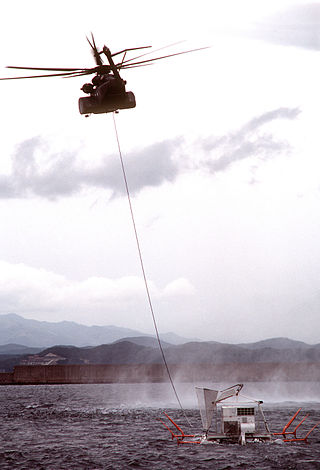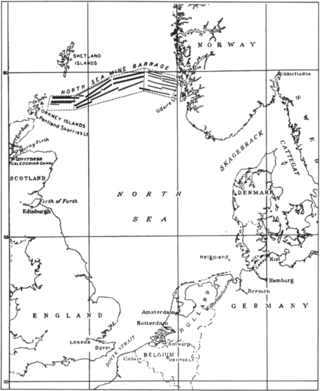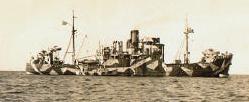
A naval mine is a self-contained explosive device placed in water to damage or destroy surface ships or submarines. Unlike depth charges, mines are deposited and left to wait until they are triggered by the approach of, or contact with, any vessel or a particular vessel type, akin to anti-infantry or anti-vehicle mines. Naval mines can be used offensively, to hamper enemy shipping movements or lock vessels into a harbour; or defensively, to protect friendly vessels and create "safe" zones. Mines allow the minelaying force commander to concentrate warships or defensive assets in mine-free areas giving the adversary three choices: undertake an expensive and time-consuming minesweeping effort, accept the casualties of challenging the minefield, or use the unmined waters where the greatest concentration of enemy firepower will be encountered.

A minesweeper is a small warship designed to remove or detonate naval mines. Using various mechanisms intended to counter the threat posed by naval mines, minesweepers keep waterways clear for safe shipping.

Minesweeping is the practice of removing explosive naval mines, usually by a specially designed ship called a minesweeper using various measures to either capture or detonate the mines, but sometimes also with an aircraft made for that purpose. Minesweeping has been practiced since the advent of naval mining in 1855 during the Crimean War. The first minesweepers date to that war and consisted of British rowboats trailing grapnels to snag the mines.

The Baltic Sea campaigns were conducted by Axis and Allied naval forces in the Baltic Sea, the Gulf of Bothnia, the Gulf of Finland and the connected lakes Ladoga and Onega on the Eastern Front of World War II. After early fighting between Polish and German forces, the main combatants were the Kriegsmarine and the Soviet Navy, with Finland supporting the Germans until 1944 and the Soviets thereafter. The Swedish Navy and merchant fleet played important roles, and the British Royal Navy planned Operation Catherine for control of the Baltic Sea and its exit choke point into the North Sea.

The North Sea Mine Barrage, also known as the Northern Barrage, was a large minefield laid easterly from the Orkney Islands to Norway by the United States Navy during World War I. The objective was to inhibit the movement of U-boats from bases in Germany to the Atlantic shipping lanes bringing supplies to the British Isles. Rear Admiral Lewis Clinton-Baker, commanding the Royal Navy minelaying force at the time, described the barrage as the "biggest mine planting stunt in the world's history." Larger fields with greater numbers of mines were laid during World War II.
Destroyer minesweeper was a designation given by the United States Navy to a series of destroyers that were converted into high-speed ocean-going minesweepers for service during World War II. The hull classification symbol for this type of ship was "DMS." Forty-two ships were so converted, beginning with USS Dorsey (DD-117), converted to DMS-1 in late 1940, and ending with USS Earle (DD-635), converted to DMS-42 in mid-1945. The type is now obsolete, its function having been taken over by purpose-built ships, designated as "minesweeper (high-speed)" with the hull classification symbol MMD.

A mine countermeasures vessel or MCMV is a type of naval ship designed for the location of and destruction of naval mines which combines the role of a minesweeper and minehunter in one hull. The term MCMV is also applied collectively to minehunters and minesweepers.

HNoMS Rauma was an Otra-class minesweeper built in 1939 for the Royal Norwegian Navy. Captured by the Germans during the 1940 invasion of Norway and renamed Kamerun, she was returned to the Norwegians after the end of the Second World War and recommissioned in 1947. Rauma remained in service until being sold for scrapping in 1963.

The Northern Barrage was the name given to minefields laid by the British during World War II to restrict German access to the Atlantic Ocean. The barrage stretched from the Orkney to the Faroe Islands and on toward Iceland. Mines were also laid in the Denmark Strait, north of Iceland.
USS Scurry (AM-304) was a steel-hulled Admirable-class minesweeper constructed for the U.S. Navy during World War II. She was crewed by sailors who were trained in minesweeping, and quickly sent to the Pacific Ocean to clear minefields so that Allied forces could invade Japanese-held beaches. For this dangerous work, often under enemy fire, she was awarded four battle stars.
Vorpostenboot, also referred to as VP-Boats, flakships or outpost boats, were German patrol boats which served during both World Wars. They were used around coastal areas and in coastal operations, and were tasked with – among other things – coastal patrol, ship escort, and naval combat.

Naval trawlers are vessels built along the lines of a fishing trawler but fitted out for naval purposes; they were widely used during the First and Second World Wars. Some—known in the Royal Navy as "Admiralty trawlers"— were purpose-built to naval specifications, others adapted from civilian use. Fishing trawlers were particularly suited for many naval requirements because they were robust vessels designed to work heavy trawls in all types of weather, and had large clear working decks. A minesweeper could be created by replacing the trawl with a mine sweep. Adding depth charge racks on the deck, ASDIC sonar below, and a 3-inch (76 mm) or 4-inch (102 mm) gun in the bow equipped the trawler for anti-submarine duties.

The R boats were a group of small naval vessels built as minesweepers for the Kriegsmarine before and during the Second World War. They were used for several purposes during the war, and were also used post-war by the German Mine Sweeping Administration for clearing naval mines.

The M class were the standard minesweeper of Nazi Germany's Kriegsmarine during World War II. The vessels were the primary force in Germany's harbor defense command and were organized administratively into minesweeper flotillas.

The German Mine Sweeping Administration (GMSA) was an organisation formed by the Allies from former crews and vessels of the Nazi Germany's Kriegsmarine for the purpose of mine sweeping after the Second World War, predominantly in the North Sea and Baltic Sea, which existed from June 1945 to January 1948.

The Fugas class were a group of minesweepers built for the Soviet Navy in the 1930s and 1940s. The Soviet designations were Project 3, Project 53, Project 53-U and Project 58.

Minesweeper flotillas of the Kriegsmarine were administrative units which grouped German minesweepers together. There were three types of minesweeper flotillas: standard minesweepers, auxiliary minesweepers, and "mine barrage" vessels. Flotilla commanders operated from a shore office, and were usually commanded by an officer ranked as a Korvettenkapitän. All minesweeper flotillas were under the command of the Führer der Minensuchboote which, by 1940, had been divided into three separate offices for activities in the North Sea, Baltic Sea, and off the coast of France.

The Kara Sea U-boat campaign was a German submarine operation in the Arctic waters of the Kara Sea during the Second World War. The plan was to repeat Operation Wunderland in Operation Husar. The Deutschland-class cruiserLützow was to sortie into the Kara Sea with U-boats in support, to attack Soviet ships.
V 103 Sylvia, later called Sperrbrecher 33, was a German steamship which was converted into a Vorpostenboot for the Kriegsmarine during World War II. Following the war, it became a part of the German Mine Sweeping Administration.















